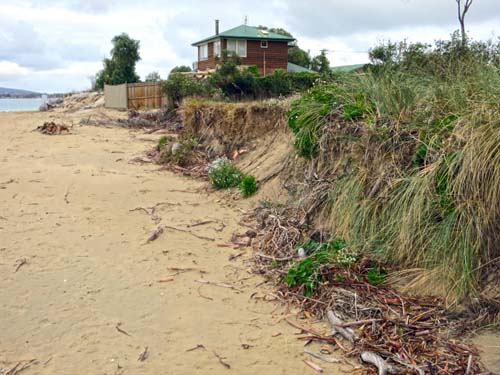Not all our news can be rendered in short sound grabs and black headlines, which makes for problems in understanding implications of the science behind rising sea levels. [10 July 2012 | Peter Boyer]

Rising seas are exacerbating damage to the shoreline at Roches Beach, one of Tasmania’s coastal areas vulnerable to even a few centimetres of sea level rise.
Patience is a virtue, my mother told me, but as virtue didn’t turn me on I remained an impatient young man. Which partly explains why I became a journalist.
One thing I liked about newspaper reporting was that you got to wipe the slate clean each day. If you had a problem it got sorted quickly, or else it wasn’t a problem at all. Every day was a new adventure. Not much need for patience.
That may be part of the reason that science is so often overlooked in news media. Scientific advances tend to be one small step at a time, whose significance, while appreciated by scientists, gets lost in the hurly-burly of a news cycle looking for the big bang.
Speaking of big bangs, last week’s probable discovery of the Higgs boson, theorised in the 1960s as a binding element in our universe, was hailed as the biggest scientific event in decades. Thousands of particle physicists celebrated.
The rest of us just had to take their word. Bemused news media reported the discovery in passing before turning to more understandable things. Ten-second grabs and huge black headlines need graphic, easily-explained events, and this wasn’t one of them.
Another case in point is the science around sea level. If sea level rise is about spectacular storm surges, it’s news. If it’s about a creeping few millimetres every year, forget it.
Forgetting may not be a good idea. These few millimetres look like growing into centimetres, radically increasing the frequency and severity of coastal flooding within our lifetimes. Quite apart from any environmental questions, there’s a lot of money tied up in waterfront property.
Last week Drs. John Hunter, John Church and Ian Allison, Hobart-based world authorities on how today’s sea level is changing, discussed the outcome of a comprehensive report on global sea level published by the Antarctic Climate and Ecosystems Cooperative Research Centre (ACE-CRC).
With co-author Tessa Jakszewicz (ACE-CRC deputy CEO), the group presents a sobering picture of sea levels past and future, and how they will affect us and people coming after us. Among their revelations:
• We’re used to stable sea levels because they’ve been that way since Jesus walked the Earth, but past glacial-interglacial fluctuations could be 100 m or more. When things got warmer and land ice melted, seas could rise as much as two metres in a century. (Bass Strait was formed at such a time.)
• A heating of the world’s atmosphere by less than 0.8C from 1850 to 2005, resulting in expansion of a warming ocean and melting of land ice, was all it took to cause sea levels to rise last century at their highest rate for 6000 years.
• Since 1961 the level of our oceans has been rising at a rate of 1.9 mm a year. From 2003 to 2009 the rate was around 3 mm a year, with satellite altimeter data showing a 3.2 mm rise. Weather changes such as the El Nino-La Nina cycle can cause fluctuations up or down.
• At even a very conservative sea level rise projection of 0.5 m by 2100, extreme coastal flooding will happen far more frequently as the century progresses. Among urban centres Sydney is especially vulnerable, but Tasmanian centres aren’t far behind. By 2100 Hobart is projected to experience severe events at least 240 times more frequently than now.
• Impact varies in different places. In sub-arctic regions where land is still rising after losing heavy ice sheets from the last ice age, rising seas will have little or no impact. Other places, including eastern USA and south-eastern England, are sinking and will be more severely affected.
• The contribution of the big Greenland and Antarctic ice sheets to sea level is now several times what it was just decades ago, a shift with huge implications. Although there’s still much uncertainty around how the big ice sheets will react to warming air and oceans, over centuries they are capable of adding many metres to sea levels.
The clear conclusion of science is that we should plan coastal development carefully, proceeding with caution and only after sea level projections and local conditions are taken fully into account. But land developers, like journalists, tend to be impatient.
Late last year the North Carolina Senate decided it was time to put a stop to the undue influence of science, with its dire predictions about the US Atlantic coast affecting prospects for coastal development.
With developers breathing down their necks, the good Senators voted that sea levels would be determined only by a particular state agency, and then only when asked by an appointed state commission. It further decided that sea level scenarios could be based only on historical data (no models, mind) and could not include “accelerated rates of sea level rise”.
In other words the law, not physical reality, would decide how sea levels would be determined.
Needless to say, North Carolina got a bucketing from scientists and others over the proposed law. Last week when the bill surfaced in the state’s lower house, legislators decided the controversial requirements should be dropped — after a “moratorium” of four years.
If the ways of God are mysterious, how about politicians?
• I was privileged a fortnight ago to share a Mercury spread with an obituary for Murray Yaxley, who died in May after a lifetime of outstanding service to education here and abroad. In the 1950s under his Mercury pen-name, “Rhombus”, he wrote highly-informed articles on current science for young readers, including an astonishingly prescient one in 1959 on sea-levels under human-induced warming. I salute him.
